Journal Description
Current Oncology
Current Oncology
is an international, peer-reviewed, open access journal published online by MDPI (from Volume 28 Issue 1-2021). Established in 1994, the journal represents a multidisciplinary medium for clinical oncologists to report and review progress in the management of this disease. The Canadian Association of Medical Oncologists (CAMO), the Canadian Association of Psychosocial Oncology (CAPO), the Canadian Association of General Practitioners in Oncology (CAGPO), the Cell Therapy Transplant Canada (CTTC), the Canadian Leukemia Study Group (CLSG) and others are affiliated with the journal and their members receive a discount on the article processing charges.
- Open Access— free for readers, with article processing charges (APC) paid by authors or their institutions.
- High Visibility: indexed within Scopus, SCIE (Web of Science), PubMed, MEDLINE, PMC, Embase, and other databases.
- Journal Rank: JCR - Q2 (Oncology)
- Rapid Publication: manuscripts are peer-reviewed and a first decision is provided to authors approximately 19.8 days after submission; acceptance to publication is undertaken in 2.4 days (median values for papers published in this journal in the second half of 2024).
- Recognition of Reviewers: APC discount vouchers, optional signed peer review, and reviewer names published annually in the journal.
Impact Factor:
2.8 (2023);
5-Year Impact Factor:
2.9 (2023)
Latest Articles
Modern Treatment of Skeletal Metastases: Multidisciplinarity and the Concept of Oligometastasis in the Recent Literature
Curr. Oncol. 2025, 32(4), 226; https://doi.org/10.3390/curroncol32040226 (registering DOI) - 11 Apr 2025
Abstract
Bone metastases are a major concern in cancer management since they significantly contribute to morbidity and mortality. Metastatic lesions, commonly arising from breast, prostate, lung, and kidney cancers, affect approximately 25% of cancer patients, leading to severe complications such as pain, fractures, and
[...] Read more.
Bone metastases are a major concern in cancer management since they significantly contribute to morbidity and mortality. Metastatic lesions, commonly arising from breast, prostate, lung, and kidney cancers, affect approximately 25% of cancer patients, leading to severe complications such as pain, fractures, and neurological deficits. This narrative review explores contemporary approaches to bone metastases, emphasizing a multidisciplinary strategy and the evolving concept of oligometastatic disease. Oligometastases, defined by limited metastatic spread (1–5 lesions), offer a potential window for curative treatment through aggressive interventions, including stereotactic ablative radiotherapy and resection surgery. Tumor boards, integrating systemic therapies with local interventions, are crucial to optimize treatment. Despite promising results, gaps remain in defining optimal treatment sequences and refining patient selection criteria. Future research should focus on personalized approaches, leveraging biomarkers and advanced imaging to enhance outcomes and the quality of life in patients with bone metastases.
Full article
(This article belongs to the Special Issue 2nd Edition: Treatment of Bone Metastasis)
Open AccessSystematic Review
A Systematic Review of Cost-Effectiveness Studies on Pancreatic Cancer Screening
by
Diedron Lewis, Laura Jiménez, Kelvin K. Chan, Susan Horton and William W. L. Wong
Curr. Oncol. 2025, 32(4), 225; https://doi.org/10.3390/curroncol32040225 (registering DOI) - 11 Apr 2025
Abstract
Background: Pancreatic cancer (PC) is among the deadliest types of cancer globally. While early detection helps avert adverse outcomes, screening is only recommended for individuals at high risk, specifically those with familial and/or genetic predispositions. The objectives of this study are to systematically
[...] Read more.
Background: Pancreatic cancer (PC) is among the deadliest types of cancer globally. While early detection helps avert adverse outcomes, screening is only recommended for individuals at high risk, specifically those with familial and/or genetic predispositions. The objectives of this study are to systematically review primary studies on the cost-effectiveness of PC screening and to identify the critical factors that influence cost-effectiveness. Methods: This systematic review was performed using PRISMA guidelines. Economic evaluation studies on PC screening were identified from searches on the SCOPUS and PubMed databases. The quality of reporting of the selected articles was assessed according to CHEERS 2022. Using predefined inclusion and exclusion criteria, two reviewers conducted the title–abstract review, full-text review, and data extraction to select relevant articles. The authors’ consensus was used to settle disagreements. The primary outcome was the incremental cost-effectiveness ratio, measured by cost per quality-adjusted life year and cost per life year saved. Results: Nine studies were selected for the final review. Most studies demonstrated that one-time screening for PC among high-risk individuals was cost-effective compared with no screening, while others found annual screening to also be cost-effective. High-risk was generally defined as having a >5% lifetime risk of PC and included individuals with either familial pancreatic cancer (FPC) or genetic susceptibility syndromes such as Peutz–Jeghers Syndrome, hereditary pancreatitis, hereditary non-polypoid colorectal cancer syndrome, familial adenomatous polyposis, and BRCA2 mutations. Individuals with new-onset diabetes (NOD) were also considered high-risk. Screening using mainly endoscopic ultrasound was cost-effective among FPC individuals and those with genetic syndromes. Risk-based screening was also cost-effective among patients with NOD. Conclusion: Screening for PC is cost-effective among selected high-risk individuals. However, cost-effectiveness depends on epidemiological factors, cost, the diagnostic performance of screening tools, and the overall design of studies.
Full article
(This article belongs to the Section Health Economics)
►▼
Show Figures

Figure 1
Open AccessArticle
Folliculin (FLCN) in Thyroid Tumors: Incidence, Significance, and Role as a Driver Gene and Secondary Alteration
by
Faisal A. Hassan, Camryn Slone, Robert J. McDonald, Julie C. Dueber, Adeel M. Ashraf, Melina J. Windon, Oliver J. Fackelmayer, Cortney Y. Lee, Therese J. Bocklage and Derek B. Allison
Curr. Oncol. 2025, 32(4), 224; https://doi.org/10.3390/curroncol32040224 - 11 Apr 2025
Abstract
Thyroid carcinomas are driven by diverse molecular alterations, but the tumor suppressor gene folliculin (FLCN), best known for its role in Birt–Hogg–Dubé (BHD) syndrome, has received limited attention in thyroid tumors. Here, we describe two thyroid tumors with pathogenic FLCN alterations—one
[...] Read more.
Thyroid carcinomas are driven by diverse molecular alterations, but the tumor suppressor gene folliculin (FLCN), best known for its role in Birt–Hogg–Dubé (BHD) syndrome, has received limited attention in thyroid tumors. Here, we describe two thyroid tumors with pathogenic FLCN alterations—one germline and one somatic—and analyze the broader prevalence and significance of FLCN in thyroid carcinomas using multiple large sequencing datasets, including ORIEN-AVATAR. Patient 1, with a germline FLCN mutation and a history of BHD syndrome, presented with a well-circumscribed oncocytic adenoma. Molecular testing confirmed biallelic FLCN inactivation, but no additional mutations or aggressive features were observed, and the patient remained disease-free post-thyroidectomy. Patient 2 harbored a somatic FLCN mutation in an oncocytic poorly differentiated thyroid carcinoma, which exhibited extensive angioinvasion, high proliferative activity, and concurrent TP53 and RB1 mutations. The tumor progressed with metastatic disease despite multimodal treatment. Thyroid carcinomas revealed FLCN alterations in 1.1% of cases. Pathogenic mutations were rare but associated with oncocytic morphology, while homozygous deletions occurred more frequently in genomically unstable tumors, including anaplastic thyroid carcinoma. These findings suggest FLCN mutations may act as early oncogenic drivers in oncocytic thyroid neoplasms, while deletions represent secondary events in aggressive tumor evolution. The lack of FLCN coverage in standard thyroid molecular panels likely underestimates its clinical relevance. Including FLCN in genetic testing could improve tumor detection and characterization, particularly in BHD patients who may benefit from routine thyroid screening. Further studies are needed to clarify FLCN’s role in thyroid cancer pathogenesis.
Full article
(This article belongs to the Special Issue 2nd Edition: Molecular Testing for Thyroid Nodules and Cancer)
►▼
Show Figures

Figure 1

Figure 1
Open AccessArticle
Computed Tomography-Based Radiomic Nomogram to Predict Occult Pleural Metastasis in Lung Cancer
by
Xiaoyi Zhao, Heng Zhao, Kongxu Dai, Xiangyu Zeng, Yun Li, Feng Yang and Guanchao Jiang
Curr. Oncol. 2025, 32(4), 223; https://doi.org/10.3390/curroncol32040223 - 11 Apr 2025
Abstract
Objectives: The preoperative identification of occult pleural metastasis (OPM) in lung cancer remains a crucial clinical challenge. This study aimed to develop and validate a predictive model that integrates clinical information with chest CT radiomic features to preoperatively identify patients at risk of
[...] Read more.
Objectives: The preoperative identification of occult pleural metastasis (OPM) in lung cancer remains a crucial clinical challenge. This study aimed to develop and validate a predictive model that integrates clinical information with chest CT radiomic features to preoperatively identify patients at risk of OPM. Methods: This study included 50 patients diagnosed with OPM during surgery as the positive training cohort and an equal number of nonmetastatic patients as the negative control cohort. Using least absolute shrinkage and selection operator (LASSO) logistic regression, we identified key radiomic features and calculated radiomic scores. A predictive nomogram was developed by combining clinical characteristics and radiomic scores, which was subsequently validated with data from an additional 545 patients across three medical centers. Results: Univariate and multivariate logistic regression analyses revealed that carcinoembryonic antigen (CEA), the neutrophil-to-lymphocyte ratio (NLR), the clinical T stage, and the tumor–pleural relationship were significant clinical predictors. The clinical model alone achieved an area under the curve (AUC) of 0.761. The optimal integrated model, which combined radiomic scores from the volume of interest (VOI) with the CEA and NLR, demonstrated an improved predictive performance, with AUCs of 0.890 in the training cohort and 0.855 in the validation cohort. Conclusions: Radiomic features derived from CT scans show significant promise in identifying patients with lung cancer at risk of OPM. The nomogram developed in this study, which integrates CEA, the NLR, and radiomic tumor area scores, enhances the precision of preoperative OPM prediction and provides a valuable tool for clinical decision-making.
Full article
(This article belongs to the Section Thoracic Oncology)
►▼
Show Figures
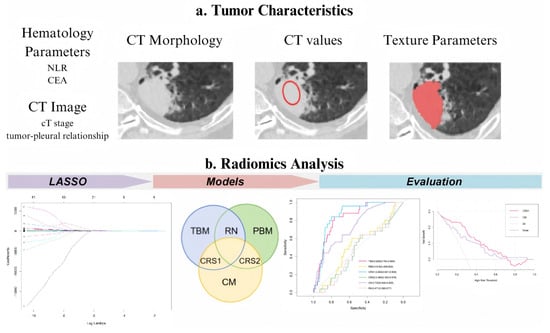
Figure 1

Figure 1
Open AccessArticle
Primary Central Nervous System Tumors in Adolescents: A Population-Based Study on Epidemiology and Clinical Pathways in a Challenging Age Group
by
Lucia De Martino, Patrizia Piga, Marcella Sessa, Camilla Calì, Camilla Russo, Stefania Picariello, Nicola Onorini, Pietro Spennato, Lucia Quaglietta, Maria Vittoria Donofrio, Giuseppe Cinalli, Francesco Vetrano and Fabio Savoia
Curr. Oncol. 2025, 32(4), 222; https://doi.org/10.3390/curroncol32040222 - 10 Apr 2025
Abstract
Background: Oncological care of adolescent patients is often inconsistent, as they frequently fall between pediatric and adult services. The Childhood Cancer Registry of Campania (CCRC) is the Italian largest population-based registry specializing in children 0–19 years old, with a target population of approximately
[...] Read more.
Background: Oncological care of adolescent patients is often inconsistent, as they frequently fall between pediatric and adult services. The Childhood Cancer Registry of Campania (CCRC) is the Italian largest population-based registry specializing in children 0–19 years old, with a target population of approximately 1.1 million inhabitants. Material and Methods: This report presents epidemiological indicators and clinical pathways on primary brain tumors in adolescents (15–19 years) from the Campania region. Results: Over the study period (2008–2020), the cohort included 219 adolescents with newly diagnosed central nervous system (CNS) tumors with an annual average incidence rate (IR) of 48.9 cases per million/year. The 5-year observed survival rate after diagnosis of CNS tumor was 84.8%. Overall, the most common tumor site was the pituitary gland and craniopharyngeal duct, representing 22.4% of all tumors. The most frequently occurring malignant primary CNS tumor was germinoma, while the most common non-malignant tumor was pituitary adenoma. Most patients were referred to adult services and nearly half migrated outside the region to receive cancer care. Conclusions: Challenges in the care of adolescent oncology patients include limited access to specialized care, difficulties in transitioning from pediatric to adult institutions, distinct tumor biology, and the underrepresentation of adolescents in clinical trials. The care of adolescents with CNS tumors is fragmented across institutions and significant variations in practice exist between adult and pediatric practitioners.
Full article
(This article belongs to the Special Issue Quality of Life and Follow-Up Care Among AYA Cancer Survivors)
►▼
Show Figures

Figure 1

Figure 1
Open AccessArticle
Developing the Understanding Palliative Care Module: A Quality Improvement Initiative Incorporating Public, Patient, and Family Caregiver Perspectives
by
Patricia Biondo, Mary-Ann Shantz, Yuanjie (Bill) Zheng, Miranda Manning and Louise Kashuba
Curr. Oncol. 2025, 32(4), 221; https://doi.org/10.3390/curroncol32040221 - 10 Apr 2025
Abstract
Improving public awareness of palliative care is crucial for improving access to, and uptake of, palliative care, which has demonstrated benefits for patients and health systems. However, there is a lack of engaging, accessible educational palliative care resources designed for public audiences. As
[...] Read more.
Improving public awareness of palliative care is crucial for improving access to, and uptake of, palliative care, which has demonstrated benefits for patients and health systems. However, there is a lack of engaging, accessible educational palliative care resources designed for public audiences. As part of a larger quality improvement initiative to strengthen awareness of palliative care, we developed “Understanding Palliative Care”—an innovative, online educational module incorporating best practices for defining and promoting palliative care to a public audience. An expert working group with representation from nursing, medicine, social work, instructional design, and care navigation advised on the development of the module. Incorporating the perspectives of Albertans with lived palliative care experience was deemed essential by the working group. We identified three Albertans (one patient and two family caregivers) of diverse ages and cultural backgrounds who had personally benefitted from palliative care and consented to record virtual interviews. We incorporated multiple interview segments into the module that highlight the physical, emotional, social, and spiritual support provided by palliative care. Finally, a panel of thirteen public volunteers provided feedback on the content, design, and navigation of the draft module. The Understanding Palliative Care module fills an important gap in Alberta, providing a free, online, evidence-based, and engaging educational tool to improve public awareness and understanding of palliative care.
Full article
(This article belongs to the Special Issue Building Hope for the Next Decade of Psychosocial Oncology: Optimizing the Integration of Supportive Care into Oncology Care)
►▼
Show Figures
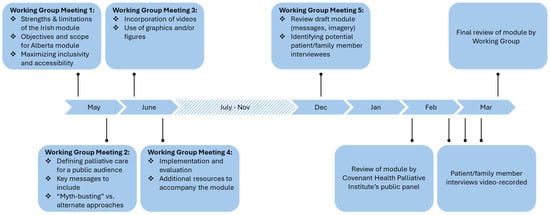
Figure 1

Figure 1
Open AccessArticle
The Role of Dysphagia on Head and Neck Cancer Patients’ Quality of Life, Functional Disabilities and Psychological Distress: Outcomes of Cancer Rehabilitation from an Observational Single-Center Study
by
Špela Matko, Christina Knauseder, David Riedl, Vincent Grote, Michael J. Fischer, Samuel Moritz Vorbach, Karin Pfaller-Frank, Wilhelm Frank and Thomas Licht
Curr. Oncol. 2025, 32(4), 220; https://doi.org/10.3390/curroncol32040220 - 10 Apr 2025
Abstract
Many patients with head-and-neck cancer (HNC) suffer from speech or swallowing disorders. We investigated the impact of dysphagia on health-related quality of life (HRQOL), functioning, and distress in HNC survivors, and whether cancer rehabilitation can alleviate these conditions. Before admission (T0) and at
[...] Read more.
Many patients with head-and-neck cancer (HNC) suffer from speech or swallowing disorders. We investigated the impact of dysphagia on health-related quality of life (HRQOL), functioning, and distress in HNC survivors, and whether cancer rehabilitation can alleviate these conditions. Before admission (T0) and at discharge (T1) of three-week inpatient cancer rehabilitation, patient-reported outcomes were collected. HRQOL, symptoms, functioning, and psychological distress were assessed with EORTC QLQ-C30 and Hospital Anxiety and Depression Scale (HADS) questionnaires. Of 63 HNC patients, 22 had dysphagia, 23 needed no speech therapy (Control-1), and 18 needed speech therapy, but showed no symptoms of dysphagia (Control-2). Before rehabilitation, HRQOL, physical, social, and emotional functioning were significantly lower in dysphagia patients than in controls. Dysphagia patients reported more severe general symptoms including fatigue, pain, sleep disturbances, nausea/vomiting, diarrhea, and financial worries. Furthermore, the emotional and social functioning of Control-2 was significantly worse than Control-1. For all HNC patients, social, emotional, and role functioning, fatigue, nausea/vomiting, insomnia, and appetite loss significantly improved at T1. Improvements in HRQOL were most noticeable in dysphagia patients. Psychooncological counseling reduced depression in dysphagia and Control-2 patients to levels seen in the general population. In conclusion, dysphagia patients suffer severely from impaired functioning and systemic symptoms but benefit substantially from rehabilitation.
Full article
(This article belongs to the Section Head and Neck Oncology)
►▼
Show Figures
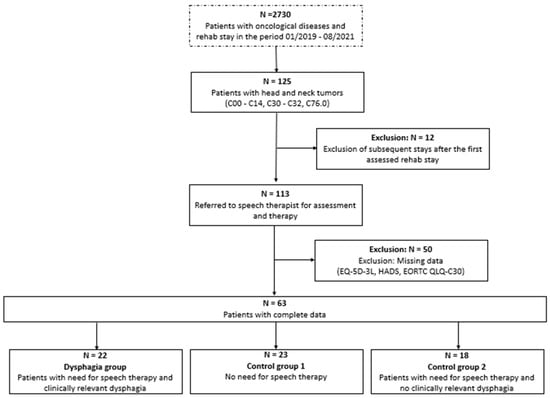
Figure 1

Figure 1
Open AccessCase Report
A Rare Malignant Case of a Primary Pseudomyogenic Haemangioendothelioma of the Bone
by
Annabella Di Mauro, Salvatore Tafuto, Lucia Cannella, Francesca Collina, Giovanni Neri, Ottavia Clemente, Imma D’Arbitrio, Francesca Ricci, Secondo Lastoria, Gerardo Ferrara and Annarosaria De Chiara
Curr. Oncol. 2025, 32(4), 219; https://doi.org/10.3390/curroncol32040219 - 10 Apr 2025
Abstract
Pseudomyogenic haemangioendotheliomas (PMH) are exceedingly rare, mostly occurring in soft tissue, with malignant cases even more uncommon. In this report, we present a case of a 28-year-old male initially suspected of having a fibroblastic osteosarcoma of the right femur, which was then correctly
[...] Read more.
Pseudomyogenic haemangioendotheliomas (PMH) are exceedingly rare, mostly occurring in soft tissue, with malignant cases even more uncommon. In this report, we present a case of a 28-year-old male initially suspected of having a fibroblastic osteosarcoma of the right femur, which was then correctly diagnosed as a primary pseudomyogenic hemangioendothelioma of the bone with synchronous metastases to other skeletal segments. Molecular analysis through targeted RNA sequencing confirmed the correct diagnosis, revealing a fusion transcript ACTB::FOSB. To our knowledge, this is one of the few reported cases of suffering from multiple pathological fractures. The rapid skeletal progression and the onset of distant metastases in this case is highly unusual considering the typically indolent clinical course commonly reported in the literature for this tumor.
Full article
(This article belongs to the Section Bone and Soft Tissue Oncology)
►▼
Show Figures
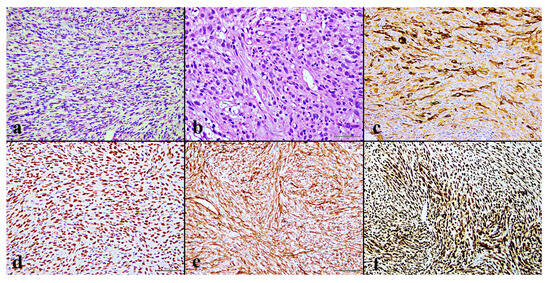
Figure 1

Figure 1
Open AccessCase Report
A Rare Case of Non-Hodgkin B-Cell Lymphoma Following Invasive Lobular Carcinoma of the Breast: A Case Report
by
Elisa Bertulla, Raquel Diaz, Matteo Mascherini, Marco Casaccia, Francesca Depaoli, Letizia Cuniolo, Chiara Cornacchia, Cecilia Margarino, Federica Murelli, Simonetta Franchelli, Marianna Pesce, Chiara Boccardo, Marco Gipponi, Franco De Cian and Piero Fregatti
Curr. Oncol. 2025, 32(4), 218; https://doi.org/10.3390/curroncol32040218 - 10 Apr 2025
Abstract
The association between breast cancer and non-Hodgkin lymphoma of the spleen is extremely rare, with very few cases documented in the medical literature. We present the case of a 39-year-old woman in good health but with a family history of breast cancer, who,
[...] Read more.
The association between breast cancer and non-Hodgkin lymphoma of the spleen is extremely rare, with very few cases documented in the medical literature. We present the case of a 39-year-old woman in good health but with a family history of breast cancer, who, in 2017, developed invasive lobular carcinoma in her right breast, which was treated with mastectomy followed by hormonal therapy. In 2024, she presented with a suspicious right axillary mass, suspected of recurrence, which was confirmed by fine-needle aspiration biopsy. The patient received neoadjuvant chemotherapy, followed by axillary lymph node dissection and bilateral adnexectomy. CT and PET scans showed suspicious splenic lesions suggestive of metastases. Infectious and hematological tests were negative, leading to the decision to perform laparoscopic splenectomy. Histological examination revealed follicular B-cell non-Hodgkin lymphoma. The patient is now in good general condition and is on a biannual follow-up. The case highlights the diagnostic complexity of tumor recurrences and the need to consider alternative diagnoses other than metastasis in oncological patients.
Full article
(This article belongs to the Section Breast Cancer)
►▼
Show Figures
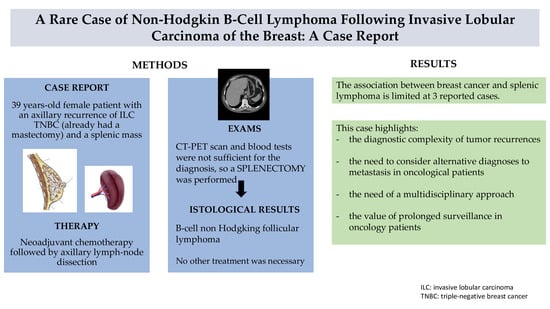
Graphical abstract

Graphical abstract
Open AccessArticle
Low-Malignant-Potential Adenocarcinoma: A Histological Category with a Significantly Better Prognosis than Other Solid Adenocarcinomas at IA Stage
by
Marco Chiappetta, Alessandra Cancellieri, Filippo Lococo, Elisa Meacci, Carolina Sassorossi, Maria Teresa Congedo, Qianqian Zhang, Diomira Tabacco, Isabella Sperduti and Stefano Margaritora
Curr. Oncol. 2025, 32(4), 217; https://doi.org/10.3390/curroncol32040217 - 9 Apr 2025
Abstract
Introduction: Low-malignant-potential adenocarcinoma has been defined as a type of non-mucinous tumor, which has a total tumor size measuring ≤ 3 cm, exhibits ≥ 15% lepidic growth, lacks non-predominant high-grade patterns (≥10% cribriform, ≥5% micropapillary, ≥5% solid), has an absence of angiolymphatic or
[...] Read more.
Introduction: Low-malignant-potential adenocarcinoma has been defined as a type of non-mucinous tumor, which has a total tumor size measuring ≤ 3 cm, exhibits ≥ 15% lepidic growth, lacks non-predominant high-grade patterns (≥10% cribriform, ≥5% micropapillary, ≥5% solid), has an absence of angiolymphatic or visceral pleural invasion, spread through air spaces (STAS), necrosis and >1 mitosis per 2 mm2. The aim of this study is to validate, with regard to cancer-specific survival (CSS) and disease-free survival (DFS), the proposed definition of LMP adenocarcinoma in an independent external cohort of lung adenocarcinoma patients having undergone surgical resection, and having presented with a long follow-up period. Methods: Clinicopathological characteristics of patients who underwent lung resection for adenocarcinoma from 1 January 2005 to 31 December 2014 were retrospectively analyzed. Patients with ground-glass opacity (GGO) and part-solid tumors, minimally invasive adenocarcinoma (MIA), adenocarcinoma in situ (AIS), tumors ≥5 cm in size, nodal involvement and/or distant metastases, patients who underwent neoadjuvant treatment, and those who had an incomplete follow-up or a follow-up shorter than 60 months were excluded. The proposed criteria for low-malignant-potential adenocarcinoma (LMPA) were tumor size ≤ 3 cm, invasive size ≥ 0,5 cm, lepidic growth ≥ 15%, and absence of the following: mitosis (>1 per 2 mm2), mucinous subtype, angiolymphatic invasion, visceral pleural invasion, spread through air spaces (STAS) and tumor necrosis. End points were disease-free survival (DFS) and cancer-specific survival (CSS). The log-rank test was used to assess differences between subgroups. Results: Out of 80 patients meeting the proposed criteria, 14 (17.5%) had the LMPA characteristics defined. The mean follow-up time was 67 ± 39 months. A total of 19 patients died, all in the non-LMPA category, and 33 patients experienced recurrence: 4 (28.5%) with LMPA and 29 (43.9%) with non-LMPA. Log-rank analysis showed 100% 10-year CSS for patients with LMPA and 77.4% for patients without LMPA, with this difference being statistically significant (p-value = 0.047). Univariate analysis showed a significant association with the cStage (AJCC eighth edition), both for CSS (p value = 0.005) and DFS (p-value = 0.003). LMPA classification did not show a statistically significant impact on CSS and DFS, likely due to the limited number of events (CSS p-value = 0.232 and DFS p-value = 0.213). No statistical association was found for CSS and DFS with pT, the number of resected nodes (< or >10) or the number of resected N2 stations (< or >2). Conclusions: Our study confirmed the prognostic role of LMPA features, with a low risk of recurrence and a good CSS and DFS. The criteria for diagnosis are replicable and feasible for application. The clinical implications of these findings, such as pre-operative prediction and surveillance scheduling, may be the topic of future prospective studies.
Full article
(This article belongs to the Special Issue The Current Status of Lung Cancer Surgery)
►▼
Show Figures
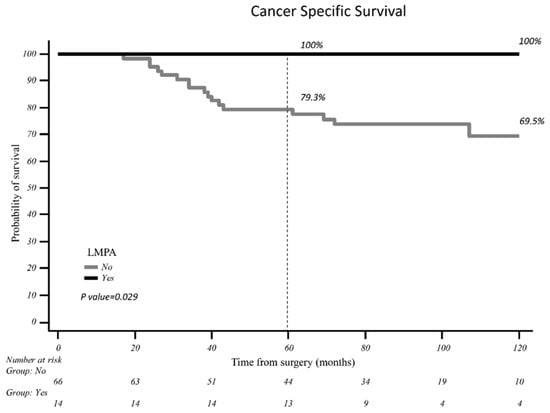
Figure 1

Figure 1
Open AccessArticle
Using Invitation Letters to Increase HPV Vaccination Among Adult Women
by
Kelly Bunzeluk, Laura Coulter, Donna Turner, Chaeyoon Jeong, Carla Krueger and Austin Hill
Curr. Oncol. 2025, 32(4), 216; https://doi.org/10.3390/curroncol32040216 - 9 Apr 2025
Abstract
(1) Background: In Manitoba, most people get the HPV vaccine through a publicly funded school-based program. If they miss the school-based program, they remain eligible for the free HPV immunization program. This study explored whether invitation and reminder letters would increase HPV vaccine
[...] Read more.
(1) Background: In Manitoba, most people get the HPV vaccine through a publicly funded school-based program. If they miss the school-based program, they remain eligible for the free HPV immunization program. This study explored whether invitation and reminder letters would increase HPV vaccine uptake among adult women who remained eligible for the publicly funded program. (2) Methods: Eligible individuals were randomized into three groups of 4650 women each. Intervention groups I and II were mailed an information package inviting them to be vaccinated. Six weeks later, intervention group II received a reminder letter if they remained unvaccinated. The control group received no correspondence related to HPV vaccination. Vaccination status, defined as at least one dose of an approved HPV vaccine, was calculated six months after the packages were mailed. (3) Results: Overall, 4.0% (3.4–4.6%, p < 0.0001) of individuals in intervention group II (invitation/reminder) and 2.5% (2.1–3.0%, p < 0.0001) of individuals in intervention group I (invitation) received one dose of the HPV vaccine. Compared to the control group, sending invitations/reminders and invitation packages increased the likelihood of getting at least one dose of the HPV vaccine by 4.9 times (3.4–6.9, p < 0.0001) and 3.0 times (2.1–4.4, p < 0.0001), respectively. (4) Conclusion: Sending invitation and reminder letters to unvaccinated women may be an effective and low-cost way to increase HPV vaccination coverage among adults who are eligible for the publicly funded immunization program.
Full article
(This article belongs to the Special Issue Action and Impact: Prevention and Screening Strategies Contributing to the Elimination of Cervical Cancer)
►▼
Show Figures

Figure 1

Figure 1
Open AccessReview
Current Limitations of Sentinel Node Biopsy in Vulvar Cancer
by
Myriam Gracia, Maria Alonso-Espías and Ignacio Zapardiel
Curr. Oncol. 2025, 32(4), 215; https://doi.org/10.3390/curroncol32040215 - 8 Apr 2025
Abstract
Background: Vulvar cancer is a rare gynecologic malignancy with increasing incidence. Lymph node status is the most critical prognostic factor, traditionally assessed through inguinofemoral lymphadenectomy, a procedure associated with significant morbidity. Sentinel lymph node biopsy (SLNB), in selected cases, has emerged as a
[...] Read more.
Background: Vulvar cancer is a rare gynecologic malignancy with increasing incidence. Lymph node status is the most critical prognostic factor, traditionally assessed through inguinofemoral lymphadenectomy, a procedure associated with significant morbidity. Sentinel lymph node biopsy (SLNB), in selected cases, has emerged as a less invasive alternative with favorable oncologic outcomes. Objective: This review summarizes current evidence on the indications, technique, safety, and oncologic outcomes of SLNB in vulvar cancer, with a focus on controversial scenarios such as recurrent and larger tumors. Methods: A narrative review of PubMed-indexed studies published in English over the last 35 years was conducted. Eligible studies included original research, systematic reviews, meta-analyses, randomized controlled trials, and case-control studies. Results: SLNB is recommended for unifocal vulvar tumors < 4 cm with stromal invasion > 1 mm and clinically negative nodes. Landmark trials, including GROINSS-V-I and GOG-173, confirmed its accuracy and lower morbidity compared to lymphadenectomy. SLNB utilization has increased since its inclusion in guidelines, with a concurrent decline in lymphadenectomy rates. Combined detection techniques are mandatory, while indocyanine green (ICG) is an emerging option. Future studies should focus on refining patient selection criteria, improving detection techniques, and clarifying the implications of low-volume nodal disease to further optimize outcomes for patients with vulvar cancer. Conclusion: SLNB is a validated, minimally invasive staging approach in early-stage vulvar cancer. Further research is needed to refine its role in high-risk cases and optimize detection methods.
Full article
(This article belongs to the Section Gynecologic Oncology)
►▼
Show Figures
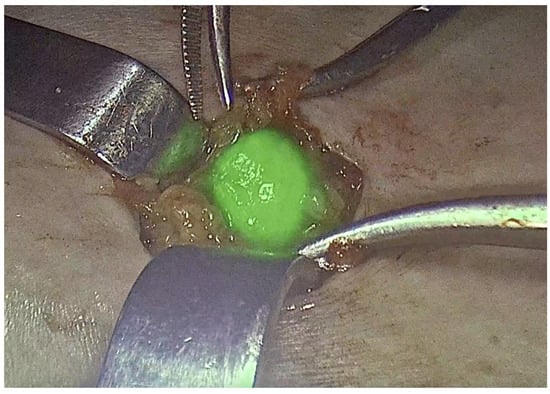
Figure 1
Open AccessReview
Survivorship Considerations and Management in the Adolescent and Young Adult Sarcoma Population: A Review
by
Allison Gunderson, Miriam Yun, Babe Westlake, Madeline Hardacre, Nicholas Manguso and Alicia A. Gingrich
Curr. Oncol. 2025, 32(4), 214; https://doi.org/10.3390/curroncol32040214 - 3 Apr 2025
Abstract
Soft tissue sarcoma (STS) has an 2–8% incidence for all malignant tumors in the adolescent and young adult (AYA) population, which are patients from ages 15 to 39. As most STS tumors are aggressive, they require multimodal management with surgery, radiation and chemotherapy.
[...] Read more.
Soft tissue sarcoma (STS) has an 2–8% incidence for all malignant tumors in the adolescent and young adult (AYA) population, which are patients from ages 15 to 39. As most STS tumors are aggressive, they require multimodal management with surgery, radiation and chemotherapy. This article discusses the survivorship considerations in this young population of cancer patients who complete therapy. The lasting side effects include surgical and radiation-related morbidity, chemotherapy toxicity, early and late secondary effects on other organ systems, such as cardiac and endocrine dysfunction, and the development of secondary cancers. The long-term psychologic and practical impacts for those who have received a sarcoma diagnosis in the prime of their life include fertility, mental health, relationship, education and career implications. Although there is a paucity of data in some of these areas, we present existing management guidelines as available. This article serves as a comprehensive review of this wide array of treatment effects intended for all providers participating in the care of AYA sarcoma survivors, to include oncologists, primary care providers and therapists.
Full article
(This article belongs to the Special Issue Quality of Life and Follow-Up Care Among AYA Cancer Survivors)
►▼
Show Figures
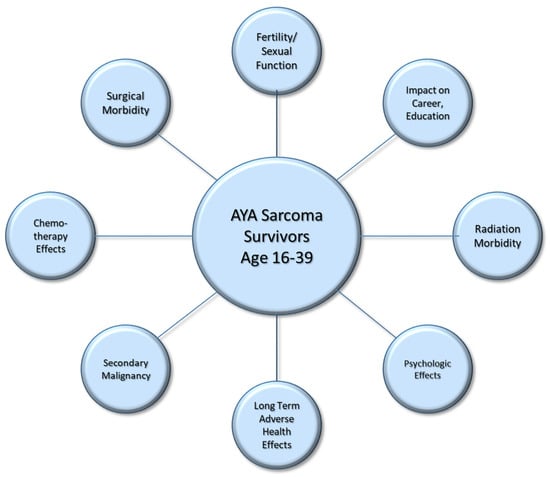
Figure 1
Open AccessArticle
Incidence of Tumour Lysis Syndrome in Patients with Acute Myeloid Leukemia During Initiation of Therapy with Azacitidine and Venetoclax: A Retrospective Chart Review from a Canadian Single-Centre Perspective
by
Tana Saiyin, Grace Christou, Mitchell Sabloff, Tina Crosbie, Kim-My Nguyen-Tham and Jill Fulcher
Curr. Oncol. 2025, 32(4), 213; https://doi.org/10.3390/curroncol32040213 - 2 Apr 2025
Abstract
Azacitidine and venetoclax (Aza-Ven) are part of a new standard of care for elderly patients with Acute Myeloid Leukemia (AML) [In line with recommendations, patients with AML at our centre were routinely admitted during initiation of Aza-Ven for close monitoring for tumour lysis
[...] Read more.
Azacitidine and venetoclax (Aza-Ven) are part of a new standard of care for elderly patients with Acute Myeloid Leukemia (AML) [In line with recommendations, patients with AML at our centre were routinely admitted during initiation of Aza-Ven for close monitoring for tumour lysis syndrome (TLS). However, hospitalization impacts patient experience and is a significant resource burden. The objectives of this study were to evaluate the incidence of TLS in this population and identify patients who could safely initiate therapy in our outpatient facility. Of the 48 patients who commenced Aza-Ven as inpatients, the incidence of TLS was 25% using Cairo–Bishop (CB) diagnostic criteria but was mostly due to transient increases in uric acid, phosphate or potassium that remained within the normal laboratory reference range. Using Howard diagnostic criteria, TLS incidence was only 2%. Patients who developed CB TLS had a significantly higher baseline white blood count (WBC; p = 0.01). Patients with WBC of less than 30 × 109/L subsequently completed outpatient initiation of Aza-Ven (n = 15). Only one of these patients developed mild, transient TLS by CB criteria but not by Howard criteria. Our results demonstrate that a significant portion of patients could safely initiate Aza-Ven in our outpatient facility and avoid unnecessary hospitalization.
Full article
(This article belongs to the Section Hematology)
►▼
Show Figures

Figure 1
Open AccessArticle
Long-Term Patient-Reported Bowel and Urinary Quality of Life in Patients Treated with Intensity-Modulated Radiotherapy Versus Intensity-Modulated Proton Therapy for Localized Prostate Cancer
by
Kimberly R. Gergelis, Miao Bai, Jiasen Ma, David M. Routman, Bradley J. Stish, Brian J. Davis, Thomas M. Pisansky, Thomas J. Whitaker and Richard Choo
Curr. Oncol. 2025, 32(4), 212; https://doi.org/10.3390/curroncol32040212 - 2 Apr 2025
Abstract
Purpose: This study aimed to compare long-term patient-reported outcomes in bowel and urinary domains between intensity-modulated radiotherapy (IMRT) and intensity-modulated proton therapy (IMPT) for localized prostate cancer. Methods and Materials: Patients with clinical T1–T2 prostate cancer receiving IMRT or IMPT at a tertiary
[...] Read more.
Purpose: This study aimed to compare long-term patient-reported outcomes in bowel and urinary domains between intensity-modulated radiotherapy (IMRT) and intensity-modulated proton therapy (IMPT) for localized prostate cancer. Methods and Materials: Patients with clinical T1–T2 prostate cancer receiving IMRT or IMPT at a tertiary cancer center from 2015–2018 were analyzed to determine the changes in the prospectively collected bowel function (BF), urinary irritative/obstructive symptoms (UO), and urinary incontinence (UI) domains of EPIC-26. The mean changes in EPIC-26 scores were evaluated from pretreatment to 24 months post-radiotherapy for each modality. A score change >50% of the baseline standard deviation was considered a clinically meaningful change. Results: A total of 82 patients treated with IMRT (52.2%) and 56 patients treated with IMPT (53.3%) completed the questionnaire at baseline and 24 months post-RT. There were no baseline differences in domain scores between treatment modalities. At 24 months post-radiotherapy, there was a significant and clinically meaningful decline in the BF mean score in the IMRT cohort (−4.52 (range −50, 29.17), p = 0.003), whereas the decline in BF score did not reach clinical relevance or significance (−1.88 (range −37.5, 50), p = 0.046) when accounting for the Bonferroni adjustment in the IMPT cohort. A higher proportion of patients treated with IMRT had a clinically relevant reduction in BF when compared with IMPT (47.37% vs. 25.93%, p = 0.017). The mean changes in the UI and UO scores of the IMRT and IMPT cohorts were neither statically significant nor clinically relevant. Conclusions: IMPT leads to a smaller decrease in BF than IMRT at 24 months post-RT, while there was no differential effect on UO and UI.
Full article
(This article belongs to the Special Issue Evolution of Treatments of Prostate Cancer: From Biology to Current Advanced Technologies)
Open AccessArticle
Merkel Cell Carcinoma of the Skin: Deducing the Pattern of Spread from an International Aggregated Database of 949 Patients
by
Patricia Tai, Kurian Joseph, Vimal H. Prajapati, Aoife Jones Thachuthara, Jidong Lian, Avi Assouline, Edward Yu and Michael Veness
Curr. Oncol. 2025, 32(4), 211; https://doi.org/10.3390/curroncol32040211 - 2 Apr 2025
Abstract
(1) Background: It is controversial if Merkel cell carcinomas (MCCs) spread to lymph nodes or distant metastases (LNM/DM) first. (2) Methods: A total of 303 patients from six institutions (March 1982–February 2015) were combined with individual patient data from a PubMed search, totaling
[...] Read more.
(1) Background: It is controversial if Merkel cell carcinomas (MCCs) spread to lymph nodes or distant metastases (LNM/DM) first. (2) Methods: A total of 303 patients from six institutions (March 1982–February 2015) were combined with individual patient data from a PubMed search, totaling 949 patients. The primary outcome was recurrence patterns. (3) Results: (a) More patients presented with lymph node metastases (LNMs) than DMs at diagnosis: 17.9% (166 among the 929 patients with known staging) vs. 1.9% (18/929); (b) 310/929 (33.4%) developed lifetime DM, of whom 220/310 also developed LNM. The majority (133 patients) of patients were documented to have developed LNM before DM. (c) A shorter median time of 1.5 months (range: 0–47.0) from initial diagnosis to LNM, versus 8 months (range: 0–107.8) to DM, was also found. Another observation was that 2.4% (23/949) of patients with primary tumors ≤1 cm developed lifetime DM, with the smallest being 0.2 cm. (4) Conclusions: Three observations support the idea that prior LNM gives rise to subsequent DM as the main pathway of dissemination in MCC. This implies that patients with nodal metastases should be considered for adjuvant systemic therapy studies as an enriched population. Participation in clinical trials is strongly encouraged.
Full article
(This article belongs to the Section Dermato-Oncology)
►▼
Show Figures

Graphical abstract

Graphical abstract
Open AccessCorrection
Correction: Dukaczewska et al. Necrosis in Preoperative Cross-Sectional Imaging and Postoperative Histology Is a Diagnostic Marker for Malignancy of Adrenocortical Tumors. Curr. Oncol. 2025, 32, 25
by
Agata Dukaczewska, Stephan R. Marticorena Garcia, Simon Ponsel, Alexandra Webster, Frederike Butz, Eva M. Dobrindt, Johann Pratschke, Peter E. Goretzki, David Horst, Martina T. Mogl and Catarina A. Kunze
Curr. Oncol. 2025, 32(4), 210; https://doi.org/10.3390/curroncol32040210 - 2 Apr 2025
Abstract
Peter E [...]
Full article
Open AccessArticle
The Relational Experience of Fear of Cancer Recurrence in Family Caregivers: A Reflexive Thematic Analysis Study
by
Jani Lamarche, Faye Ajmera, Jonathan Avery, Ghizlène Sehabi, Sophie Lebel and Rinat Nissim
Curr. Oncol. 2025, 32(4), 209; https://doi.org/10.3390/curroncol32040209 - 1 Apr 2025
Abstract
Fear of cancer recurrence (FCR) affects approximately 50% of family caregivers. While FCR in cancer patients has been well-documented, less is known about the experience of FCR in family caregivers. This study aimed to qualitatively explore the distinct characteristics of FCR in family
[...] Read more.
Fear of cancer recurrence (FCR) affects approximately 50% of family caregivers. While FCR in cancer patients has been well-documented, less is known about the experience of FCR in family caregivers. This study aimed to qualitatively explore the distinct characteristics of FCR in family caregivers. A focus group and semi-structured interviews were conducted via videoconferencing with family caregivers of cancer survivors (stages I–III, finished treatment, no recurrence). Participants were recruited through Canadian hospitals, community partners, and social media. The focus group and qualitative interviews explored family caregivers’ experiences of FCR, including its content, frequency, impact, and management. A reflexive thematic analysis was used. In total, twenty family caregivers participated. Six participated in the focus group. Sixteen participated in the interviews. Two participated in both. Family caregivers described their experience of FCR as all-consuming, constant, and marked by a sense of helplessness. Qualitative analysis revealed a major theme of relational aspects of FCR in family caregivers, with the following four inter-related themes: patient-centric hypervigilance, self-silencing, FCR as isolating, and finding support. This qualitative study examined the experiences of family caregivers living with FCR. Our findings highlight that relational factors shape how family caregivers experience and manage their FCR. High-quality survivorship care should be redefined to include FCR interventions tailored to family caregivers.
Full article
(This article belongs to the Section Psychosocial Oncology)
Open AccessArticle
Cancer Recurrence in Operated Primary Oral Squamous Cell Carcinoma Patients Seems to Be Independent of the Currently Available Postoperative Therapeutic Approach: A Retrospective Clinical Study
by
Shahram Ghanaati, Samuel Ebele Udeabor, Anne Winter, Robert Sader and Anja Heselich
Curr. Oncol. 2025, 32(4), 208; https://doi.org/10.3390/curroncol32040208 - 1 Apr 2025
Abstract
Despite advances in treatment, recurrence rates in oral squamous cell carcinoma (OSCC) remain high. Prognostic outcomes vary in terms of local recurrence, metastasis, and overall survival. A retrospective cohort analysis was conducted on OSCC patients who underwent primary surgery at the Department of
[...] Read more.
Despite advances in treatment, recurrence rates in oral squamous cell carcinoma (OSCC) remain high. Prognostic outcomes vary in terms of local recurrence, metastasis, and overall survival. A retrospective cohort analysis was conducted on OSCC patients who underwent primary surgery at the Department of Craniomaxillofacial and Facial Plastic Surgery, University Medical Center Frankfurt, between January 2014 and December 2020. Demographic data, tumor characteristics, surgical details, intraoperative frozen section results, and recurrence patterns were first assessed for availability. Subsequently, the available data relevant to each endpoint were analyzed. A total of 169 patients were analyzed (mean age: 64 years). The tongue was the most affected site and had the highest recurrence rate, followed by the floor of the mouth. Overall, 24.3% of patients experienced recurrence, with most cases occurring within the first year. T2 tumors had the highest recurrence rates. Between patients with and without adjuvant therapy, recurrence rates were comparable. Positive surgical margins were more common in recurrence cases, but no significant correlation was found between margin status and recurrence in patients without adjuvant therapy. Based on the analyzed data, achieving recurrence-free survival in OSCC does not solely depend on surgical technique or adjuvant therapy. Instead, early recognition of individual tumor characteristics and even tumor biology should guide personalized treatment planning. Notably, tumors of the tongue and floor of the mouth exhibited high recurrence rates regardless of disease stage, raising the question of whether primary chemoradiotherapy (CRT) could achieve better outcomes than surgery. Further studies are needed to evaluate the role of CRT as a first-line treatment for OSCC in these locations.
Full article
(This article belongs to the Section Head and Neck Oncology)
►▼
Show Figures
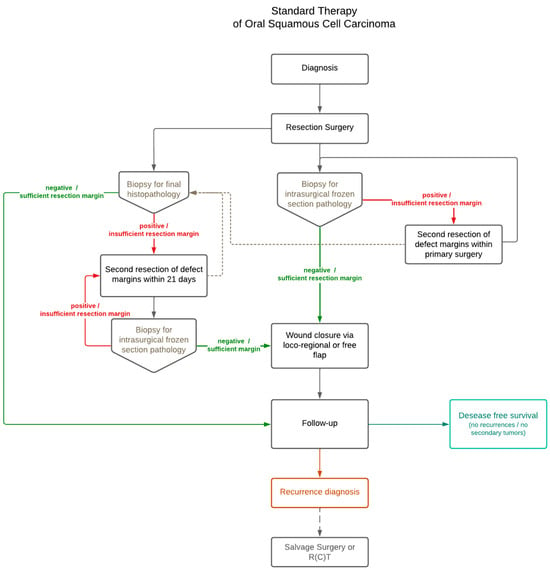
Figure 1

Figure 1
Open AccessGuidelines
Canadian Expert Consensus Recommendations for the Diagnosis and Management of Glioblastoma: Results of a Delphi Study
by
Warren P. Mason, Rebecca A. Harrison, Sarah Lapointe, Mary Jane Lim-Fat, Mary V. MacNeil, David Mathieu, James R. Perry, Marshall W. Pitz, David Roberge, Derek S. Tsang, Christina Tsien, Frank K. H. van Landeghem, Gelareh Zadeh and Jacob Easaw
Curr. Oncol. 2025, 32(4), 207; https://doi.org/10.3390/curroncol32040207 - 1 Apr 2025
Abstract
Glioblastoma is the most common and aggressive malignant brain tumor in adults, with an increasing incidence and a poor prognosis. Current challenges in glioblastoma management include rapid tumor growth, limited treatment effectiveness, high recurrence rates, and a significant impact on patients’ quality of
[...] Read more.
Glioblastoma is the most common and aggressive malignant brain tumor in adults, with an increasing incidence and a poor prognosis. Current challenges in glioblastoma management include rapid tumor growth, limited treatment effectiveness, high recurrence rates, and a significant impact on patients’ quality of life. Given the complexity of glioblastoma care and recent advancements in diagnostic and treatment modalities, updated guidelines are needed in Canada. This Delphi study aimed to develop Canadian consensus recommendations for the diagnosis, classification, and management of newly diagnosed and recurrent glioblastoma. A multidisciplinary panel of 14 Canadian experts in glioblastoma care was convened, and a comprehensive literature review was conducted to synthesize evidence and formulate initial recommendations. Consensus was achieved through three Delphi rounds, in which panelists rated their agreement with recommendation statements on a five-point Likert scale. Statements with ≥75% agreement were accepted, and others were revised for re-voting. Final recommendations were formulated based on the consensus level, strength of evidence, clinical expertise, and consideration of the Canadian healthcare context. These recommendations aim to standardize glioblastoma diagnosis and classification across Canada, provide evidence-based guidance for optimal treatment selection, integrate novel therapies, and enhance the overall quality of care for glioblastoma patients.
Full article
(This article belongs to the Section Neuro-Oncology)
►▼
Show Figures

Figure 1

Figure 1

Journal Menu
► ▼ Journal Menu-
- Current Oncology Home
- Aims & Scope
- Editorial Board
- Reviewer Board
- Topical Advisory Panel
- Instructions for Authors
- Special Issues
- Topics
- Sections & Collections
- Article Processing Charge
- Indexing & Archiving
- Editor’s Choice Articles
- Most Cited & Viewed
- Journal Statistics
- Journal History
- Journal Awards
- Society Collaborations
- Conferences
- Editorial Office
Journal Browser
► ▼ Journal Browser-
arrow_forward_ios
Forthcoming issue
arrow_forward_ios Current issue - Volumes not published by MDPI
Highly Accessed Articles
Latest Books
E-Mail Alert
News
Topics
Topic in
Cancers, Cells, JCM, Radiation, Pharmaceutics, Applied Sciences, Nanomaterials, Current Oncology
Innovative Radiation Therapies
Topic Editors: Gérard Baldacchino, Eric Deutsch, Marie Dutreix, Sandrine Lacombe, Erika Porcel, Charlotte Robert, Emmanuelle Bourneuf, João Santos Sousa, Aurélien de la LandeDeadline: 30 April 2025
Topic in
Biomedicines, Current Oncology, Diagnostics, Gastrointestinal Disorders, JCM, Livers, Transplantology
Advances in Gastrointestinal and Liver Disease: From Physiological Mechanisms to Clinical Practice
Topic Editors: Davide Giuseppe Ribaldone, Gian Paolo CavigliaDeadline: 20 June 2025
Topic in
Biomolecules, CIMB, Sci. Pharm., Cancers, Current Oncology, Cells
The Role of Extracellular Vesicles as Modulators of the Tumor Microenvironment
Topic Editors: Nils Ludwig, Miroslaw J SzczepanskiDeadline: 30 June 2025
Topic in
Cancers, Diagnostics, JCM, Current Oncology, Gastrointestinal Disorders, Biomedicines, Therapeutics
Hepatobiliary and Pancreatic Diseases: Novel Strategies of Diagnosis and Treatments
Topic Editors: Alessandro Coppola, Damiano Caputo, Roberta Angelico, Domenech Asbun, Chiara MazzarelliDeadline: 20 August 2025

Conferences
Special Issues
Special Issue in
Current Oncology
Application of Nuclear Medicine in Cancer Diagnosis and Treatment
Guest Editor: Michele KlainDeadline: 15 April 2025
Special Issue in
Current Oncology
The Evolving Role of Surgery in Multidisciplinary Care for Sarcoma Patients
Guest Editors: Russell G. Witt, Elizabeth Lilley, Heather LyuDeadline: 30 April 2025
Special Issue in
Current Oncology
Quality of Life and Follow-Up Care Among AYA Cancer Survivors
Guest Editors: Neetu Chawla, Sandra A. MitchellDeadline: 30 April 2025
Special Issue in
Current Oncology
Cost Effectiveness vs. Affordability in the Age of Targeted Drug Therapies
Guest Editor: Ramy SalehDeadline: 30 April 2025
Topical Collections
Topical Collection in
Current Oncology
New Insights into Prostate Cancer Diagnosis and Treatment
Collection Editor: Sazan Rasul
Topical Collection in
Current Oncology
New Insights into Breast Cancer Diagnosis and Treatment
Collection Editors: Filippo Pesapane, Matteo Suter
Topical Collection in
Current Oncology
Editorial Board Members’ Collection Series in "Exercise and Cancer Management"
Collection Editors: Linda Denehy, Ravi Mehrotra, Nicole Culos-Reed
Topical Collection in
Current Oncology
Editorial Board Members’ Collection Series: Contemporary Perioperative Concepts in Cancer Surgery
Collection Editors: Vijaya Gottumukkala, Jörg Kleeff






